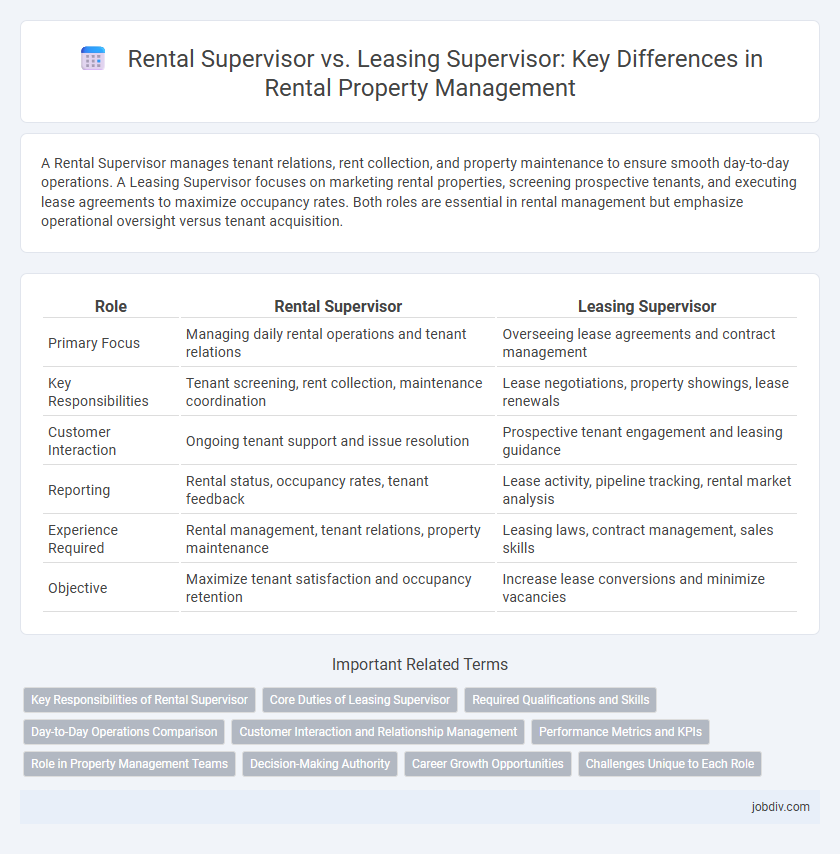A Rental Supervisor manages tenant relations, rent collection, and property maintenance to ensure smooth day-to-day operations. A Leasing Supervisor focuses on marketing rental properties, screening prospective tenants, and executing lease agreements to maximize occupancy rates. Both roles are essential in rental management but emphasize operational oversight versus tenant acquisition.
Table of Comparison
| Role | Rental Supervisor | Leasing Supervisor |
|---|---|---|
| Primary Focus | Managing daily rental operations and tenant relations | Overseeing lease agreements and contract management |
| Key Responsibilities | Tenant screening, rent collection, maintenance coordination | Lease negotiations, property showings, lease renewals |
| Customer Interaction | Ongoing tenant support and issue resolution | Prospective tenant engagement and leasing guidance |
| Reporting | Rental status, occupancy rates, tenant feedback | Lease activity, pipeline tracking, rental market analysis |
| Experience Required | Rental management, tenant relations, property maintenance | Leasing laws, contract management, sales skills |
| Objective | Maximize tenant satisfaction and occupancy retention | Increase lease conversions and minimize vacancies |
Key Responsibilities of Rental Supervisor
Rental Supervisors oversee property maintenance, coordinate tenant relations, and manage rental payment collections to ensure smooth daily operations. They supervise maintenance staff, handle lease violations, and maintain accurate records of rental agreements and occupancy rates. Their role is critical in maximizing property profitability and ensuring tenant satisfaction through effective property management.
Core Duties of Leasing Supervisor
Leasing Supervisors oversee tenant relations, lease agreements, and property showings to maximize occupancy rates and tenant retention. They coordinate leasing agents, ensure compliance with rental policies, and manage lease documentation to streamline the rental process. Their core duties emphasize tenant acquisition, lease negotiation, and maintaining positive landlord-tenant relationships.
Required Qualifications and Skills
A Rental Supervisor typically requires expertise in property maintenance, tenant relations, and conflict resolution, along with strong organizational skills and experience in managing rental agreements. A Leasing Supervisor demands proficiency in marketing rental properties, conducting lease negotiations, and ensuring compliance with housing laws, combined with excellent sales and communication abilities. Both roles benefit from a background in property management and customer service, but the Leasing Supervisor focuses more on tenant acquisition and lease administration while the Rental Supervisor emphasizes ongoing property operations and tenant satisfaction.
Day-to-Day Operations Comparison
A Rental Supervisor manages daily rental unit inspections, tenant move-ins and move-outs, and coordinates maintenance requests to ensure property condition and tenant satisfaction. A Leasing Supervisor primarily oversees property showings, processes lease applications, conducts background checks, and negotiates lease terms to maximize occupancy rates. Both roles require strong communication skills but differ in operational focus, with Rental Supervisors concentrating on tenant retention and property upkeep, while Leasing Supervisors focus on attracting and securing new tenants.
Customer Interaction and Relationship Management
Rental Supervisors primarily manage tenant relations by addressing maintenance requests, resolving complaints, and ensuring lease compliance, fostering a positive rental experience. Leasing Supervisors concentrate on customer interaction during the leasing process, including property showings, lease negotiations, and onboarding new tenants to maximize occupancy rates. Both roles require strong communication skills, but Leasing Supervisors emphasize sales and tenant acquisition while Rental Supervisors focus on ongoing relationship management and tenant retention.
Performance Metrics and KPIs
Rental Supervisors focus on occupancy rates, rent collection efficiency, and maintenance turnaround times to ensure high tenant satisfaction and property profitability. Leasing Supervisors prioritize lease-up velocity, concession rates, and tenant retention ratios to drive smooth lease execution and maximize rental income. Both roles leverage key performance indicators like tenant turnover rate and lease renewal percentages for operational excellence.
Role in Property Management Teams
Rental Supervisors oversee tenant move-ins, rent collection, and day-to-day property operations, ensuring occupancy and maintenance coordination. Leasing Supervisors focus on marketing rental units, screening applicants, and managing lease agreements to maximize property revenue. Both roles collaborate closely within property management teams to enhance tenant satisfaction and operational efficiency.
Decision-Making Authority
A Rental Supervisor primarily manages daily rental operations and has decision-making authority over tenant approvals, rent collection, and maintenance scheduling. In contrast, a Leasing Supervisor holds greater responsibility in strategic lease negotiations, contract approvals, and compliance enforcement with leasing policies. The Leasing Supervisor typically exercises higher-level decision-making, influencing rental portfolio growth and tenant retention strategies.
Career Growth Opportunities
Rental Supervisors primarily manage daily operations and tenant relations, gaining hands-on experience in property maintenance and client services, which can lead to roles in property management or operations oversight. Leasing Supervisors focus on tenant acquisition, lease negotiations, and marketing strategies, developing skills that pave the way to careers in leasing management or real estate sales leadership. Both roles offer distinct career growth opportunities tailored to either operational management or strategic leasing development within the real estate industry.
Challenges Unique to Each Role
Rental Supervisors manage tenant relations and property maintenance, facing challenges like coordinating repair schedules and handling tenant disputes promptly. Leasing Supervisors focus on marketing properties, lease negotiations, and tenant screening, encountering challenges such as meeting occupancy targets and ensuring compliance with leasing regulations. Both roles require strong communication and organizational skills but differ in operational versus strategic priorities.
Rental Supervisor vs Leasing Supervisor Infographic

 jobdiv.com
jobdiv.com